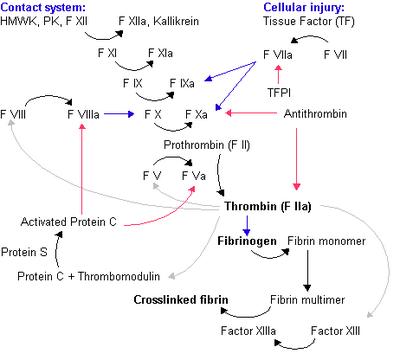The pathogenesis of chronic spontaneous urticaria (CU) may be associated with thrombin generation through the extrinsic coagulation pathway. Little is known about the components of the intrinsic coagulation pathway potentially involved.
This Japanese study included 36 patients with CU.
Classical coagulation assays revealed elevated levels in patients with CU: fibrinogen, D-dimer, and fibrin and fibrinogen degradation products (FDP).
All parameters of a global coagulation test, APTT clot waveform analysis, showed a hypercoagulable pattern and were significantly correlated to disease severity of CU.

The coagulation cascade. Legend: Black arrow = conversion/activation of factor. Red arrows = action of inhibitors. Blue arrows = reactions catalysed by activated factor. Grey arrow = various functions of thrombin. Image source: Wikipedia, public domain.
CU is characterized by elevated blood coagulation potential with involvement of the intrinsic coagulation factors, which may contribute in vivo to the generation of fibrin even by small amounts of thrombin. Asthma is also associated with a procoagulant state in the bronchoalveolar space (Blood, 01/2012).

Diagnosis of Chronic Urticaria (click to enlarge the image).

Chronic Urticaria Treatment (click to enlarge the image).
References:
Increase of coagulation potential in chronic spontaneous urticaria. Takeda T, Sakurai Y, Takahagi S, Kato J, Yoshida K, Yoshioka A, Hide M, Shima M. Allergy. 2010 Nov 17. doi: 10.1111/j.1398-9995.2010.02506.x.
This Japanese study included 36 patients with CU.
Classical coagulation assays revealed elevated levels in patients with CU: fibrinogen, D-dimer, and fibrin and fibrinogen degradation products (FDP).
All parameters of a global coagulation test, APTT clot waveform analysis, showed a hypercoagulable pattern and were significantly correlated to disease severity of CU.

The coagulation cascade. Legend: Black arrow = conversion/activation of factor. Red arrows = action of inhibitors. Blue arrows = reactions catalysed by activated factor. Grey arrow = various functions of thrombin. Image source: Wikipedia, public domain.
CU is characterized by elevated blood coagulation potential with involvement of the intrinsic coagulation factors, which may contribute in vivo to the generation of fibrin even by small amounts of thrombin. Asthma is also associated with a procoagulant state in the bronchoalveolar space (Blood, 01/2012).
Diagnosis of Chronic Urticaria (click to enlarge the image).
Chronic Urticaria Treatment (click to enlarge the image).
References:
Increase of coagulation potential in chronic spontaneous urticaria. Takeda T, Sakurai Y, Takahagi S, Kato J, Yoshida K, Yoshioka A, Hide M, Shima M. Allergy. 2010 Nov 17. doi: 10.1111/j.1398-9995.2010.02506.x.